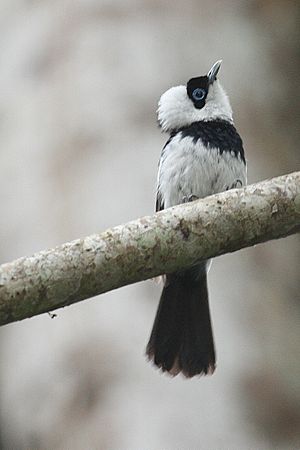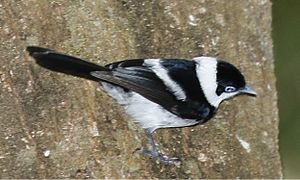Pied monarch facts for kids
Quick facts for kids Pied monarch |
|
|---|---|
 |
|
| Male in Australia | |
| Conservation status | |
| Scientific classification | |
| Genus: |
Arses
|
| Species: |
kaupi
|
The pied monarch (Arses kaupi) is a type of bird that belongs to the monarch-flycatcher family, Monarchidae. These birds are found only in coastal Queensland, Australia.
Contents
About the Pied Monarch
The pied monarch was first described by a scientist named John Gould in 1851. He thought about giving it its own special group because of its unique feet and the ring around its eye. The first time anyone described its nest and eggs was in 1894, when Robert Hislop found them near the Bloomfield River.
The pied monarch is very similar to two other birds in the Arses group. Scientists sometimes group these birds together because they are so alike.
Different Types of Pied Monarchs
There are two main types, or subspecies, of the pied monarch:
- A. k. terraereginae - Found in eastern Cape York Peninsula (north-eastern Australia).
- A. k. kaupi - Found in south-eastern Cape York Peninsula (north-eastern Australia).
Sometimes, these two types mix where their homes meet, like near Mossman. This means they can look a bit like each other in those areas.
Other Names for the Pied Monarch
This bird has many other names! Some people call it the:
- Australian pied flycatcher
- Australian pied monarch
- Banded monarch
- Pied monarch-flycatcher
- Black-breasted flycatcher
- Kaup's flycatcher
- Pied flycatcher
What Does the Pied Monarch Look Like?
The pied monarch is a small bird, about 15 to 16 centimeters (6 inches) long. It weighs around 12.5 to 15 grams (about half an ounce). The male and female birds look a bit different, which is called sexual dimorphism.
Male Pied Monarchs
Male pied monarchs have a black head and upper body. Their tail is also black. Their wings are brownish-black, but they have white feathers on their shoulders. These white feathers look like a white crescent shape across their back when their wings are folded. They have a white collar that can stand up, and this white color connects to a white throat. They also have a black band across their chest, and their belly and underside are white.
Female Pied Monarchs
Female pied monarchs have less white on their throat and collar. Their collar doesn't go all the way around their neck.
Eyes, Beaks, and Feet
Both male and female pied monarchs have black eyes with a blue ring around them. The blue ring is not as clear in females. Their bill is blue-grey, and their legs are black. Young birds look like females but are not as brightly colored. They don't have blue eye-rings, and their bill is a horn color.
Like other birds in its group, the pied monarch has long back toes and claws. Its feet are shaped a bit like those of Australasian treecreepers. They use their feet to climb tree trunks and find food in the same way.
Where Do Pied Monarchs Live?
Pied monarchs live in tropical forests along the coast of north-eastern Queensland, Australia. You can find them from Cooktown down to Ingham. They live from sea level up to about 900 meters (3,000 feet) high. They also like areas with palm trees, forests along rivers, and places where the forest meets open land.
Most pied monarchs stay in one place and do not migrate. However, some birds might move to the Eucalyptus woodlands in the Atherton Tableland during the winter months.
This bird lives in a small area, and it's not very common. But much of its home is protected in national parks or World Heritage Sites. This means their habitat is safe. Because of this, the IUCN says the pied monarch is a species of "Least Concern", meaning it's not currently in danger.
Pied Monarch Behavior
Pied monarchs mostly eat insects. They have been seen eating beetles, moths, and butterflies. They are usually seen alone or in pairs. Sometimes, you might see small groups of three to five birds, which are probably family groups.
They often join other bird groups that are looking for food together. These groups might include other monarch flycatchers, fantails, and whistlers.
How They Find Food
Within the forest, pied monarchs usually look for food in the middle parts of the trees, not often close to the ground. One special way they find food is by climbing up tree trunks and large branches, just like a treecreeper. They will poke around in the bark and moss to find insects. They also catch insects while flying in the air.
Reproduction and Life Cycle
The breeding season for pied monarchs is from October to January. They usually raise one group of young birds during this time.
Nests and Eggs
Their nest is shaped like a shallow cup. It's made from vines and sticks, woven together with spider webs and soft plant material. They often decorate the outside of the nest with lichen. Nests are usually built on a hanging loop of vine, away from the main tree trunk or leaves. They are placed about 2 to 10 meters (6 to 33 feet) above the ground.
Female pied monarchs lay two eggs. The eggs are oval-shaped and white with a pink tint. They have lavender and reddish-brown spots. Each egg is about 19 mm long and 14 mm wide.
See also
 In Spanish: Monarca pío para niños
In Spanish: Monarca pío para niños



